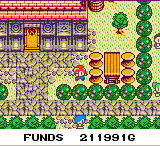 ... ...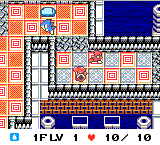
Azure Dreams is an RPG that originally appeared on the Sony Playstation and was ported to the Game Boy Color, courtesy of Konami. It borrows elements from various games such as Pokemon (monster-catching), Harvest Moon (town simulation), Diablo (random dungeons), and Lufia 2's Ancient Cave (endurance test), and manages to put them together in a way that is unique and challenging. While it lacks some of the charm and features of its PSX predecessor, GBC Azure Dreams is still one of the better entries into the Game Boy RPG department.
GRAPHICS:
7.5/10Azure Dreams is compatible with all versions of Game Boy, but naturally looks best when played on a Game Boy Color or Game Boy Advance, as it makes use of a full color scheme. At first glance, Azure Dreams resembles the typical RPG world: An overhead view with small characters reminiscent of early 8-bit Final Fantasy or Dragon Warrior games. However, there is a lot more detail in the backgrounds. The town looks and feels like a real town, not just a bunch of buildings thrown around. When you talk to certain characters, you'll sometimes get a close-up, anime-style cinema scene of their faces, which are very nicely drawn. The tower backgrounds are not as spectacular as the town's graphics. There is far less detail and the floor patterns tend to be repetitive, especially in the basement. Objects and enemies are small, but at least it's easy to tell what everything is. When fighting monsters, sometimes you'll be switched to a close-up battle view, which shows the enemy in the upper-right and your character in the lower-left, a la Pokemon. The enemies in these scenes are large and well-detailed, and their color represents what type of elemental magic they use, ie, red = fire, blue = water, green = wind. Azure Dreams also has one of the best Super Game Boy borders I've ever seen, consisting of a lovely drawing of the sky, desert, tower, and town of Monsbaiya.
 ... ...
SOUND:
8/10Azure Dreams has one of the best Game Boy soundtracks I've ever heard. The music, for the most part, is lighthearted RPG fluff, but it's very catchy and mood-fitting. I like how different shops around the town have different themes. The tower music is very good, but can become annoyingly repetitious because it usually doesn't change for about 10 floors or so (even more in the basement). The first theme in the tower is a recreation of the tower music from the PSX version. My two particular favorites are the theme in the Floor of the Sky, which is soft and melodic, and the third basement theme, which, like most of the basement music, has a more menacing tone. The sound effects are standard Game Boy sounds. They aren't annoying, but nothing stands out that's worth mentioning.
CONTROL:
7.5/10The control in Azure Dreams is fairly simple. Walking around is simple, and you can hold down B to run faster. Manipulating the item menus can sometimes be confusing, especially when buying or selling stuff at the shops. In the towers, you never have direct control over your monsters (familiars). Your familiars will act as you've instructed them to act in the menu screens. If you set their AI to "Follow Silently", they will follow you without attacking enemies. If you set it to "Be Aggressive", they will automatically run over to any enemy they see and start attacking. This is convenient and keeps the game moving along quickly, but sometimes, my familiar would get "stuck" and I'd be unable to lure him around a corner or out of some other situation. I would have to keep switching his AI to get him to follow me, again. Kou can attack enemies, too, if you face them and press the A button. Therefore, combat is very simplistic, being turn-based, but without use of menus.
 ... ...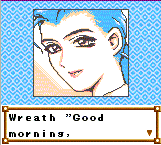
STORY/ATMOSPHERE:
6.5/10I have mixed feelings about Azure Dreams's story, and unfortunately, these feelings have been influenced by the fact that I've played and finished the PSX version. The story goes as such: Kou's father was the greatest Monster Tamer, ever, but one day he disappeared inside the Tower of Monstrosity, which looms over the desert town of Monsbaiya. On his sixteenth birthday, Kou is now old enough to enter the Monster Tower and begin his quest to not only find and tame monsters, but to solve the mystery of his father's disappearance. Many characters from the PSX version return, such as Kou's arch-rival Ghosh, the tomboy Nico, the item-shop owner Fur, and Ghosh's bimbo sister Selfi. However, many of these characters were toned down and altered from their PSX selves, often leaving them with little personality. Ghosh does have a slightly more active role in the plot, and he now has a duck named Quack that he interacts with for some comic relief. There are also some new characters who did not appear in the PSX game, but none of them really add much, if anything, to the story. Kou also does not date the women in this game as he did in the PSX version. While the first half of the game mirrors the PSX game's plot, the second half is totally new, which makes the story feel more complete. Unfortunately, the game is lacking atmosphere due to the loss of all the town events that gave the PSX Azure Dreams much of its charm and character.
CHALLENGE:
4/10Azure Dreams is a bit low on challenge. Most of it comes from trying to reach the top floor of the Tower of Monstrosity. Every time Kou enters this tower, he will always begin at experience level 1. It does not matter how high you build his level, as it will always revert back to level 1 once you exit the tower. His familiars, however, will keep all levels that they've gained. Therefore, your familiars will do most of the fighting for you. You will start out weak, and once you run out of power, you'll have to return to the town. The higher your familiars' levels are, the higher up you'll be able to get in the tower. The familiars level up quickly, and you can find plenty of items that will permamently increase their levels and stats, so the game moves along rather quickly. Azure Dreams also uses a "rock-paper-scissors" system in which familiars of a particular elemental type are weak (or strong) against familiars of another type. For example, a low-level fire-type familiar may still be able to beat a high-level wind-type familiar, since wind is weak against fire. Familiars can also be fused together to make them stronger and sometimes change their form. My best familiars became powerhouses rather quickly, allowing me to conquer the first part of the tower in a relatively short amount of time. Upon completing the tower, the 99-level basement opens up to you. There are a few boss fights, but many of them were easily beaten on the first try. While actually completing the game is not so difficult, a secondary challenge would be to try to fill out your "Monster Book", which you do by acquiring the game's 116 different familiars. Unfortunately, some of the familiars can only be gotten through fusion, and there's no plausible way of knowing what two familiars will give you the desired results. There is a Fortune Teller, but she really is not much help on that matter.
FUN:
7.5/10Although short on challenge and story, Azure Dreams is still a fun and addicting game. Although it borrows the monster-catching aspect from Pokemon, any similarity between the two games ends there. Azure Dreams feels more like a simulation game than an RPG, partially because you don't do much direct fighting, and partially because the whole entire game world consists of only the town and the tower. Most of the game's action will take place in the 30-floor Tower of Monstrosity. Each time you enter the tower, the floor designs will change to any number of randomly selected patterns. This prevents the gameplay from becoming too repetitive, since each time you go up a floor, it will be different than the last time you were there. The game limits you to taking a maximum of five items into the tower, but there is usually a plethora of items in the tower to find, so it isn't really necessary to take a whole lot. The tower is also where you will find monster eggs which can be hatched into familiars. The items that you will find in the tower are generated purely at random. Aside from the tower, there are also a few sidequests to perform in the town of Monsbaiya. However, this part of the game is not as fully-developed as it was in the PSX version. Even without comparisons, it seems like there just isn't enough to do in the town. But the biggest disappointment about GBC Azure Dreams is not its lack of challenge, altered characters, or missing town events. My biggest complaint with the game is that you can only keep up to 20 of your familiars at a time. That's 20 out of a possible 116! It almost makes the monster-catching feel pointless, when that is one of the game's major focuses.
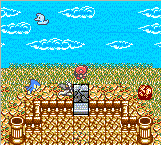 ... ...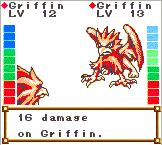
Azure Dreams is certainly one of the better Game Boy RPGs I've played. It is easy, but addicting, fast-paced, and fun. It's nice to see an RPG that emphasizes other features besides tedious level-building. If you've played the PSX version, this may be disappointing, even though there are many more monsters to catch. Otherwise, it's a good game that I can easily recommend to Game Boy owners.
OVERALL
SCORE (not an average): 7/10
BACK TO GAMEBOY
REVIEWS
GO TO AZURE DREAMS SHRINE
BACK TO MAIN
PAGE
|
|